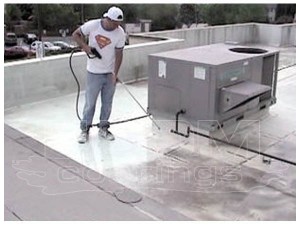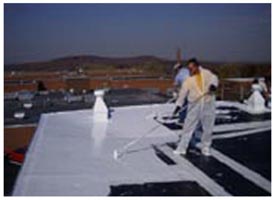You should opt for liquid rubber as it is a very useful, efficient and unique matter which has been used as a roofing solution with tremendous success. It was originally created by Kuraray Co. Ltd. in 1972 as a thick, viscous liquid which is derived from butadiene, isoprene and/or styrene. It is transparent and odorless. One of the primary uses is that it is used at a “Reactive Plasticizer”. It comes in liquid form and when used, it cures to form a hard and sturdy surface holding almost any required shape. It is successfully used for a variety of purposes, ranging from toys which are molded to useful roofing solutions.

Liquid rubber has been specially used all over the North America for over 20 years, in places and areas where extreme temperature spikes and fluctuations is a norm. It is very easy to use and an extremely productive seamless waterproof membrane. Due to its special characteristics, it can easily meet most of the health, safety and environmental requirements, and therefore provides great industrial and commercial benefits.
Applying liquid rubber is a simple, hassle-free and safe process. You can apply it on the required surface area using a brush and roller which is more appropriate for small scale residential projects. The large scale projects, for which you can use it, include factory or warehouse roofing which uses a spray system. It can be sprayed on the required surface area and this method can be used to cover up to a thousand square meters in a single day. This method is generally referred to as “Instant Set”, and it does exactly what the name suggests – the liquid rubber takes the required shape naturally and instantly, giving you instant waterproofing. Since the rubber that is sprayed is cold, it also eliminates any potential fire hazards, and it forms itself quickly as singular and seamless membrane. Since this method does not require the usage of any fleeces or primers, this method of roofing has proved to be up to five times faster than many other comparable roofing solutions.
Its unique composition gives its users an astonishing elasticity of up to 1100% along with a startling memory of 95%. It is almost unparalleled when used as a roofing solution on roofs which are expected to face excessive movements.

This roofing solution provides similar advantages to that of EPDM roofing solution – it offers protection against ozone and heat, as well as provides good resistance against polar substances and steam. Additionally, liquid rubber roof is also resistant to water, salt and alkalis. It also gives a smooth, crease-free surface, and is easy to apply. The only issue with this type of roofing is that you cannot directly apply it to asphalt roofs or asphalt shingles. You need to first apply a coat of acrylic solution on which the liquid rubber can then set itself.
Ping Back here: Why You Should Opt for Liquid Rubber? – Epdmcoatings.com


